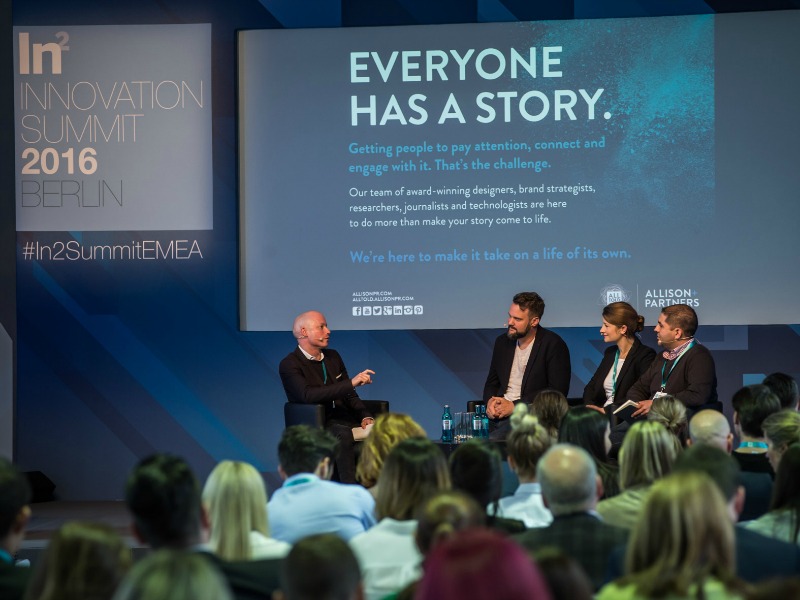Arun Sudhaman 27 May 2016 // 1:51PM GMT

Our third In2 Innovation Summit in EMEA was another fascinating affair, bringing together a top-notch lineup of marketing and communications leaders to The Station in Berlin.
A lively mix of panel discussions and lightning talks left many delegates with plenty of food for thought, illustrated by the #in2summitEMEA hashtag. To help distil the learnings from the conference, here are five things that emerged with particular resonance from the day's discussions:
1. Conventional storytelling is not exactly dead
We can all accept that the traditional messaging model is rapidly going extinct, and not before time. But, as Kaspersky Lab's head of strategic projects Rainer Bock pointed out in a discussion that was adeptly moderated by Allison+Partners UK MD Jim Selman, the loss of control must count as an opportunity to engage in genuine storytelling rather than the fictionalised notion of brand control. "As long as the PR pro was controlling storytelling we were not able to be great storytellers," said Bock "We lost control so why not tell amazing stories instead of self-congratulating bullshit." The key requirement, as former Mirror online editor Shiraz Lalani pointed out, is that "people have to be adaptable — and immersed in the world around them."
2. Neurological triggers hold plenty of promise
Another reason as to why storytelling retains specific power comes from the way the human brain reacts to information. In a highly entertaining lightning talk, behavioural biologist and H+K Strategies Denmark CEO Bo Øksnebjerg broke down some easy neurological triggers that can help your next campaign. For example, the 'Ikea effect' suggests that people will engage with something far more if they do it themselves. And concepts such as 'social proof' need to become standard thinking for today's communicators, along with more common elements like humour and positive reinforcement.
That type of thinking holds true not just for consumer brands, but even for an organisation like the European Central Bank. Deputy director-general of communications Thierry Bracke was candid about the bank's issues when it comes to "selling the Euro" amid a climate of rising Euroscepticism and criticism of Eurozone economic policy. As Bracke noted, rational arguments — punctuated by weighty, jargon-heavy reports — are one thing, but a more emotionally-resonant approach is needed to truly engage and persuade people.
3. Internal challenges are as big as external ones
Pressure from outside sources is often viewed as one of the key drivers of change in the communications world. But internal factors are probably just as important, as delegates learned at the conference. Stack Overflow EMEA marketing head Natalia Radcliffe-Brine pointed out that there remains concern about the loss of control involved in modern storytelling techniques, particularly when brands commit to crowdsourcing. "There is a challenge with other stakeholders in your business," said Radcliffe-Brine. "You do have to articulate stories differently. That’s why it’s really important for the communicators within a company to really understand that you have a consistent brand message."
Meanwhile, Telefonica UK director of reputation and communications Nicola Green spoke eloquently about how board members are her 'internal clients.' "PR objectives need to be aligned with business objectives, driving a business benefit",," she noted. "I have to make sure each of the board members understand the value that PR is bringing."
4. Communities are more valuable than consumers
At Stack Overflow, Radcliffe-Brine relies heavily on the company's community of developers to help shape her story. "The benefits are we as marketers and communicators don’t have to be the sole source of stories anymore," she points out. "Obviously it does make it more difficult when you cannot control things, but the benefit is when you work hand in hand with the community."
That kind of thinking is already well established in the political arena — digital strategist Jimmy Larsson from the Swedish Social Democratic Party has found plenty of success using digital platforms like Snapchat to engage with younger people. And an excellent example from the consumer world comes from Nike+, described by WE Communications international president Alan VanderMolen (in a nod to Shakespeare) as "a transformational epic that started in 2006 and continues to move with its actors — non-linear and realtime."
But it is also becoming increasingly critical in the rather more rarefied world of luxury brands, where influencer marketing and digital experiences are creating an opportunity that many companies are still probably too risk-averse to truly grasp.
5. Are brands ready to make virtual a reality?
The hype around virtual reality is making it the latest must-have for today's marketers, even as they interchangeably use the term with augmented reality, 360-video and mixed reality. Weber Shandwick's Adam Clyne and Patrick Chaupham noted that immersive brand experiences are now a reality, with 500m in VR headset sales expected within the next decade. The technology, however, should not distract from the more important consideration — quality content remains a must. "Virtual reality is about driving an immersive emotional connection," said Chaupham. And that, unquestionably, is something that all brands would do well to keep in mind.


































.jpg)

















